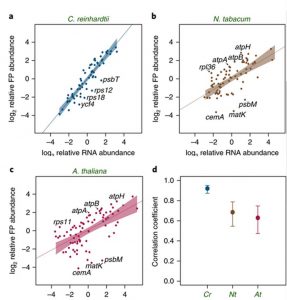Divergent strategies to maintain steady state protein levels in algal and angiosperm chloroplasts (Nature Plants)
 Plants and their algal predecessors both utilize chloroplasts for photosynthesis and other essential metabolic processes. The endosymbiotic origin and subsequent co-evolution of this autotrophic organelle introduced striking regulatory mechanisms combining both prokaryotic and eukaryotic strategies for optimal functionality and control. In a recent article, Trosch et al. (Nature Plants) performed a comprehensive comparison of chloroplast transcription and translation in a model chlorophyte alga (Chlamydomonas reinhardtii) and two model angiosperms (Arabidopsis thaliana and Nicotiana benthamiana) to assess the conservation of regulatory mechanisms in chloroplasts. Through a combination of chloroplast ribosome profiling and transcriptomics, the authors discovered a high similarity in steady state protein levels despite significant differences in transcriptional abundances across these organisms. Together, their work argues that these divergent lineages have developed distinct strategies to maintain protein synthesis in chloroplasts. (Summary by Phil Carella) Nature Plants 10.1038/s41477-018-0211-0
Plants and their algal predecessors both utilize chloroplasts for photosynthesis and other essential metabolic processes. The endosymbiotic origin and subsequent co-evolution of this autotrophic organelle introduced striking regulatory mechanisms combining both prokaryotic and eukaryotic strategies for optimal functionality and control. In a recent article, Trosch et al. (Nature Plants) performed a comprehensive comparison of chloroplast transcription and translation in a model chlorophyte alga (Chlamydomonas reinhardtii) and two model angiosperms (Arabidopsis thaliana and Nicotiana benthamiana) to assess the conservation of regulatory mechanisms in chloroplasts. Through a combination of chloroplast ribosome profiling and transcriptomics, the authors discovered a high similarity in steady state protein levels despite significant differences in transcriptional abundances across these organisms. Together, their work argues that these divergent lineages have developed distinct strategies to maintain protein synthesis in chloroplasts. (Summary by Phil Carella) Nature Plants 10.1038/s41477-018-0211-0



